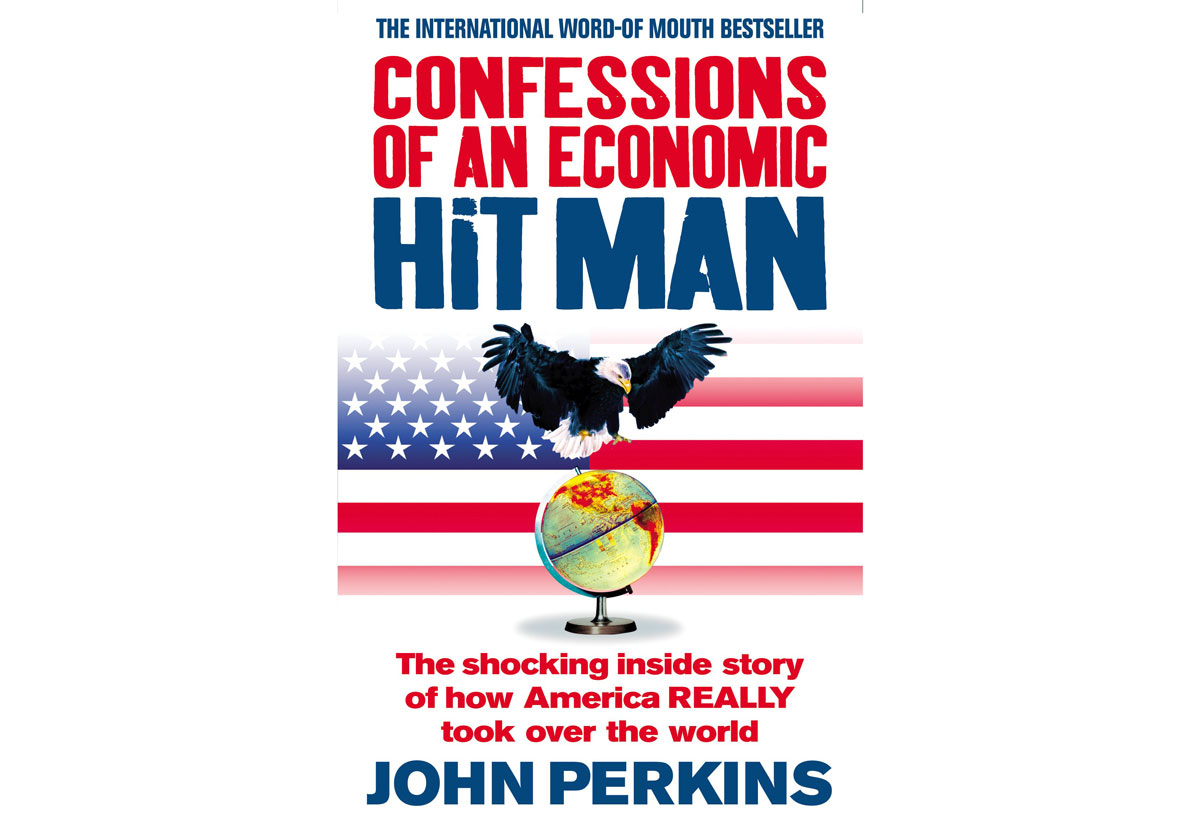Confessions of an Economic Hit Man
By John Perkins. San Francisco: Berrett-Koehler Publishers, 2004. 264 pp., $24.95
John Perkins was once a self-described “economic hit man” (EHM) who infiltrated developing countries with suitcases of money to capture their leaders with bribes and loans and extract huge concessions from them for U.S. business interests. His story as revealed in his book made the New York Times Best Seller List, and has been celebrated by reviewers as an eye-opening insider expose of America’s role in the world.
Perkins begins his story by telling us about how he was recruited by the U.S. National Security Agency (NSA) and later urged to join the Peace Corps in Ecuador to gain familiarity with developing countries. During his stay with an indigenous Indian tribe in Ecuador, he was recruited by a private international consulting firm (MAIN) that was in charge of studies to determine whether the World Bank should lend Ecuador and its neighboring countries funds to build hydroelectric dams and other infrastructure projects. Perkins was not an economist. In preparation for his new career as an economic hit man, he enrolled in a couple of courses on econometrics and was trained by a handler about the primary objectives of his work: to justify huge international loans that would funnel money back to MAIN and other U.S. companies (such as Bechtel, Halliburton, Stone & Webster, and Brown & Root) through massive engineering and construction projects. He would produce studies that projected economic growth twenty to twenty-five years into the future and evaluate the impacts of a variety of projects within this framework.
His first task was to devise a twenty-five-year forecast of inflated electricity needs for Indonesia. After Sukarno had been replaced by Suharto, Perkins was told to “develop this master plan . . . make sure that oil industry and all the others that serve it get whatever they are likely to need” (25). He came up with a growth forecast in electric demand averaging 19 percent per annum for twelve years after the new system was completed, tapering down to 17 percent for eight more years, and then holding at 15 percent for the remainder of the twenty-five-year projection. The Indonesian government, the Asian Development Bank, and USAID experts were satisfied with the results; Perkins’s career as an economic hit man was launched with success.
In the following chapters of his book, Perkins tells us about different versions of a similar story of how U.S. hegemony was established with the help of EHMs like himself. If bribes and IMF advice were not enough to get the job done, the “jackals” were called in. He lists the following events as successful jackal “hits”: the CIA’s coup against Iran’s Mossadegh; the atrocities committed by his replacement, Big Oil’s puppet, the Shah; the Saudi Arabian money-laundering affair; the jackal-orchestrated assassinations of Ecuador’s President Jaime Roldos and Panama’s President Omar Torrijos; allegations of collusion between oil companies and missionary groups in the Amazon; the international activities of Bechtel, Halliburton, and other pillars of American capitalism; the unilateral and unprovoked U.S. invasion of Panama and capture of Manuel Noriega; and the coup against Venezuelan President Hugo Chavez.
Although the events covered in the book are a matter of public record, Perkins’s way of putting them together might be appealing and engaging to a beginner-level student of social sciences. With his almost schematic presentation of debt traps for developing countries and the international financial order, as well as his discussion of the environmental impacts of oil exploitation in Indonesia and Ecuador, Perkins provides a compelling account for students of international or development economics. In many places, he points to problems with the mainstream branch of economics that still dominates the area of practice: enrolling in a “couple of courses in econometrics” was enough formal education for him to be appointed as an economic consultant in large-scale projects. He points to the “deceptive nature of GNP” as a measure of economic progress and criticizes the “trickle-down” hypothesis of growth: “[M]y college professors had not understood the true nature of macroeconomics: that in many cases helping an economy grow only makes those few people who sit atop the pyramid even richer, while it does nothing for those at the bottom except to push them even lower. Indeed, promoting capitalism often results in a system that resembles medieval societies” (26).
Students love this book. In my course on principles of macroeconomics, students talked about how they could not put the book down, how much they learned, how they did not know about this level of U.S. involvement in the rest of the world, and so on. I could tell that Perkins’s well-written and simplified account of events presented in a spy-thriller style was working. However, his basic thesis is no surprise to those familiar with the critical literature on the influence of the World Bank and the IMF on developing countries. See for example Stiglitz (2002) or Easterly (2001). Revealing the secret mechanisms of the involvement of American corporations in the rest of the world, Perkins’s book might provide an attractive complementary account to these critiques, but it is not a substitute for them.
Despite his deployment of terms such as empire and corporatocracy, his account of globalization is fused with nostalgia for a lost American republic betrayed by the “mistakes” of those who govern our institutions (219). In Perkins’s view, the U.S. involvement in the rest of the world is nothing more than a series of errors waiting to be corrected. Perkins warns his reader that “there is nothing wrong with banks, corporations and governments . . . and that they certainly do not have to compose a corporatocracy . . . . The fault lies not in the institutions themselves . . . ” (222). Perkins also has advice as to what we can “do to stop the corporatocracy and to end this insane and self-destructive march to global empire” in his epilogue: cut back on your oil consumption and shopping sprees and get some exercise in the occasional protest. This, I believe, is why the book is well loved even by supporters of the global marketplace, who emphasize its benefits even as they acknowledge some costs. Historical analysis does not seem required to understand the current global world. To suggest that the neo-imperialist order be understood as a series of mistakes would be to suggest that imperialism never happened and that colonialism was just a question of sloppy thinking. What emerged as global order today operates on principles that are very similar to those of imperialism, not because things have gone badly, but rather because things have gone more or less as planned by supporters of U.S. hegemony. Current institutions of global order are not eternal, ahistorical organizations that happen to serve wrong goals at the hands of those with erroneous understanding of the developing world. Banks, corporations, and nation-states are the main pillars of the conditions of existence for neo-imperialist order. Perkins’s account falls short because it substitutes historical and political myopia for honest historical analysis.
His constant announcement of allegiance to the founding fathers of his country reflects his problematic understanding of the world order. He points to the heroism and idealism of Jefferson, Paine, and Revere as guiding principles that can correct our mistakes and recreate the lost world of the Lincoln Republic. Pointing to the empire overseas as a recent “mistake” misses the four-hundred-plus years of internal empire at home. U.S. hegemony and imperial tendencies in the rest of the world have not emerged in isolation from experiences of Native Americans, African slaves, other oppressed groups, and the working class of this country. America, the book tells us, is a land of innocents, and all we must do to reclaim our purity is to buy a hybrid or write our Congressman. Perkins’s account is neither honest, nor a sound analysis of global world order.
Overall, the book makes for a blend of personal narrative and geopolitical conniving that is an appealing, easy read for a first-time introduction to the world system. However, one has to place Perkins’s confessions and advice in a more analytical framework to understand the current world system.—Armagan Gezici
References
Easterly, W. 2001. Elusive quest for growth: Economists’ adventures and misadventures in the tropics. Cambridge, MA: MIT Press.
Stiglitz, J. 2002. Globalization and its discontents. New York: Norton.
Source: Review of Radical Political Economics, Summer 2008





